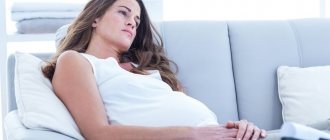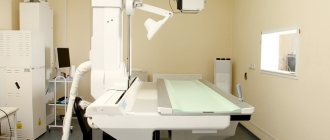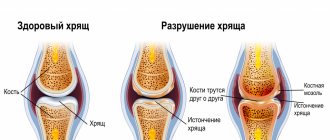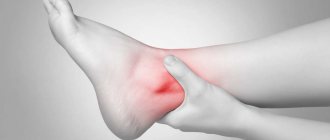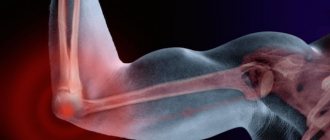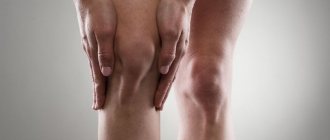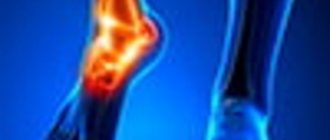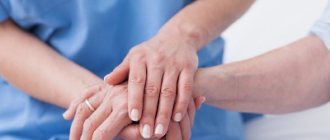The idea that post-workout pain is normal is actually incorrect and can lead to a number of dangerous consequences. Yes, a slight burning sensation in the muscles is normal, but when it comes to joints, you need to be careful. So, if your knees hurt after working out in the gym or at home, especially if this happens regularly, and the discomfort does not go away for a long time or even gets worse with each session, you need to think about why this happens and what to do in this situation.
Overtraining and knee pain
If you regularly load yourself more than necessary, and also eat incorrectly, the knee joint, which is very vulnerable, will eventually show this through degenerative-dystrophic processes. Although its strength is quite considerable, because it constantly faces loads, supporting the weight of your body, nevertheless, the capabilities of the joint are not limitless. If you neglect your health, internal tissue inflammation may occur, which will subsequently lead to the destruction of cartilage and bone deformation. If your knees hurt regularly after training, you can pay attention to the following methods:
- Several times a day, apply something cold to your knees and hold for 10-15 minutes . Low temperatures combat swelling of soft tissues.
- In the evening, lie on your back, raising your legs above your head and placing a cushion under your knees. This also helps fight swelling and joint fatigue.
- After training, you can use warming and pain-relieving ointments for knee pain. They will help overcome pain and improve blood circulation.
If the pain persists for more than two days, no matter what you do, it is best to consult a podiatrist.
Intense strength training is always stressful for the knee, but if a person is healthy, it should recover quickly. However, overtraining, combined with other problems such as poor nutrition, heredity, age, certain diseases, and so on, reduces the ability of the knee joint to recover. Accumulating in tissues, pathological changes can lead not only to pain, but also to very serious chronic diseases.
Why do athletes develop arthrosis?
As a rule, the reason is excessive stress on the joints, under the influence of which the cartilage layer quickly wears out and becomes covered with cracks. But there are other provoking factors:
- The joints suffer most when running, as well as sports games accompanied by monotonous movements (football, hockey, tennis, boxing).
- The desire to quickly lose weight through cardio training also does not lead to anything good. Excess weight already has a bad effect on the condition of the joints, and with monotonous loads, such as running on a track or jumping rope, the joints have practically no chance.
- Smoking negatively affects the synthesis of collagen protein, which is responsible for the elasticity of the connective tissue of the cartilage layer. Smoking and excessive physical activity are a direct path to arthrosis.
Physical overexertion leads to stretching of the tendons and ligaments that stabilize the joint. Edema impairs blood supply, and if the situation is accompanied by mechanical damage to the cartilage, it is gradually destroyed. The periarticular tissues and intra-articular capsule become inflamed - the properties of the synovial fluid change, which means arthrosis is not far off.
Are you involved in extreme sports? Be especially attentive to the condition of your joints
Potentially dangerous sports
| Kinds of sports | Joints that may be affected |
| Weightlifting, powerlifting, bodybuilding | Elbow, knee, spinal joints |
| Outdoor sports games | Knees, ankles |
| Wrestling, gymnastics | Knees |
| Skiing | Knees |
| Tennis, arm wrestling | Elbow, wrist |
| Running, professional cycling | Knees, ankles |
| Jumping | Leg joints |
Age-related changes
It’s hard to argue with statistics, but they show that the older a person is, the higher his risk of getting a knee injury. The reason is that over the years, collagen synthesis in the body decreases. This is a natural process, and it is difficult to argue with nature.
However, sometimes you can take courses containing gelatin and collagen. They help restore cartilage, strengthen bones and ligaments, and reduce pain in the joints. You can also sometimes undergo physiotherapy courses: massage, electrophoresis, amplipulse helps. Another excellent recovery method is the kneeling technique, which Dr. Bubnovsky often advises patients.
My knee hurts after dancing, what should I do?
Healing and restoration activities
Have you been struggling with JOINT PAIN for many years without success?
Head of the Institute: “You will be amazed at how easy it is to cure your joints by taking the product for 147 rubles every day.
The treatment prescribed is complex: action on the cause of the disease, reduction of symptoms and restoration of cartilage in the joint.
For example, herbal teas are excellent for relieving inflammation and swelling: Herbal preparations will help cure inflammatory processes in the knees.
Our readers successfully use Artreid to treat joints. Seeing how popular this product is, we decided to bring it to your attention. Read more here...
- Sprains and tears of the ligaments of the joint capsule of the knee.
- Knee injuries.
- Bursitis of the knee joint.
- Traumatic injuries of the meniscus.
- Bone fractures and the condition after a fracture of adjacent bones.
- Dislocation and ordinary subluxation in the knee joint.
Injuries
If your knees hurt after training, and this is not the first time, it may be a bruise, sprain, rupture or other injury. Any problem of this nature requires examination by a specialist, since the correct diagnosis must initially be made.
Depending on the injury, the nature and location of pain may differ. So, when the cruciate anterior ligament is sprained or torn, the knee may lose stability and become too mobile. And if after training there is pain in the back of the knee, the cause may be an injury to the femur, as well as a pinched nerve in the lumbar region due to osteochondrosis, radiating to the knee joint.
To prevent injury, consider the following points:
- Before training, be sure to do a warm-up, which will consist of gentle warming up and stretching exercises. This will make it possible to maintain joint flexibility and reduce the risk of injury.
- To immobilize the knee joints, you can use a two-meter elastic bandage . It is better to check with your trainer regarding the method of wrapping your leg.
Pain in the knee joint during flexion and extension: a complete list of causes, how to treat the disease
Symptoms of changes in the knee joint
- When bending the knee, a feeling of discomfort or pain appears, accompanied by a suitable crunch.
- Aching or cutting sensations in the knee joint.
- Increase in local temperature.
- Persistent pain after physical activity.
- Pain in the knee when straightening after sleep.
- Going up or down stairs causes pain in the knee joints.
- Swelling of the joint and changes in the skin are symptoms of an infectious inflammatory process or degenerative configuration of the articular surfaces and cartilage tissue. There may be an accumulation of water in the joint capsule.
- Crunching in the knee when bending and limited movement when walking. Paroxysmal painful spasms lasting from a couple of minutes to a couple of hours.
- Throbbing pain and muscle cramps that occur after a slight load on the knee joints, for example, when kneeling for a few minutes or during a short walk.
Diagnostics
Identifying direct and indirect events that cause pain when bending the leg will form the basis of a correct diagnosis. Treatment of the knee begins only after the patient has undergone a complete examination.
- constant pain;
- discomfort in the knee joints;
- frequent relapses of chronic knee diseases.
In addition, important for prevention:
A timely treatment and preventive course will help avoid serious complications:
A detailed article on how to treat knee joints with folk remedies.
Causes of knee pain during flexion and extension
Healing is adjusted and lasts only after the permission of the treating doctor. For home use, it is prescribed only after appropriate training and instruction. If painful feelings appear, physiotherapy is stopped. There should not be acute pain in the joint after physiological procedures or therapeutic exercises. Healing gymnastics is carried out under the guidance of a specialist.
- Drink a decoction of flax seeds three times every day. This will improve the metabolism and trophism of inflamed tissues in the joint. It is prepared like this: pour two tablespoons of flax seeds into 300 ml of hot water, boil for 10 minutes and leave for about an hour. Take the resulting decoction throughout the day;
- juniper berry tea has a mild diuretic effect and good anti-inflammatory effect;
- decoctions of clover and parsley also have a general strengthening and antitumor effect;
- a drink made from mint herb and birch leaves is useful for all configurations of the knee joints. Pour a glass of boiling water into equal parts of 100 g of dry collection and leave in a thermos for one hour. Drink during the day;
- eating pumpkin in any form has an unrivaled effect on the general condition, minimizing the inflammatory process in the knees;
- carrot juice with lemon and cucumber juices enrich the body with vitamins;
- A cabbage leaf can be applied to an unhealthy knee for any type of illness. The leaf is crushed a little to release the juice and wrapped around the knee. Cover the top with compress paper or polyethylene. If there is no skin damage or allergic reactions, you can smear a cabbage leaf with honey and apply it to your knee. Cover everything with wool or cotton cloth. Leave for 2 to 4 hours.
Preventive actions
Vegetable and fruit juices will help improve water-salt metabolism in the body and fill all organs and systems with vitamins. If you experience severe pain in the knee joint and adjacent muscles during flexion and extension, you should consult a doctor and undergo an examination. It is necessary to balance the diet, limit the content of salt and products that retain fluid in the body. First of all, overload on the knee joints is limited, bed rest is recommended.
Common diseases that cause pain:
- Dire working conditions.
- Playing sports with uneven overloads.
- Excess weight.
- Pregnancy.
Another reason is oncological diseases, the identification and treatment of which occurs only in a hospital setting and under the supervision of the attending doctor.
- UHF.
- Electrophoresis with pharmaceuticals.
- Warming up with paraffin.
- Mud healing.
- Herbal baths.
- Magnetotherapy.
The examination is carried out using the following methods:
- arthrosis;
- polyarthritis;
- gout;
- arthritis;
- diseases in the lumbar spine;
- infectious diseases;
- purulent process in the joint;
- diseases of the endocrine system;
- osteoporosis.
Find out the consequences of knee bruises from a fall and how to treat the injured joint.
Basic medical treatment is supported by the appointment of physiotherapeutic procedures, healing exercises and massage.
- Bactericidal drugs.
- Anti-inflammatory pharmaceuticals.
- Preparations that restore tissue trophism.
- Medicines that normalize blood circulation.
- Vitamin complexes.
Depending on the severity of the disease, treatment can take place in a hospital or clinic. All physical overloads on the knee joint are excluded. Medicines are prescribed in the form of pills or injections. Before use, a test for an allergic reaction is carried out regularly.
- Suppuration in the knee joint.
- Surgical interventions.
- Destruction of cartilage tissue.
- Degenerative changes in bone tissue.
Preventive examination and consultation are mandatory if:
The causes of disturbances may be local changes and disturbances in the functioning of the whole organism. There are many reasons for the occurrence of pain when bending, therefore, in order to identify the main cause, make a diagnosis and prescribe a course of treatment, it is important to undergo a full examination. In case of a complicated condition, all procedures are carried out as a hospital.
Compresses are made for no more than two hours (as they cool, they are removed earlier). Wearing a special knee brace or applying an elastic bandage is only recommended by a doctor. You can relieve pain when bending with the help of specific ointments and compresses. Ointments are selected symptomatically.
For all types of pathologies of the knee joints that cause pain during flexion and extension, a salt-free diet is prescribed. The cooking process should be steamed or in the oven. You can have boiled foods without spicy seasonings. Preference in food is given to fruits and fresh vegetables.
Inflammatory processes in the knee joint
Inflammation can manifest itself due to repeated bruises and damage to joints, vitamin deficiency, infections, metabolic disorders, weak immunity, and so on. However, among athletes, the most common causes of inflammatory processes are injuries to the extremities, and this applies to both knee and elbow joints. This could be bursitis - inflammation of the knee joint, which, if left untreated, can lead to atrophy of all the muscles nearby. Synovitis is an accumulation of fluid in the joint cavity, which provokes stiffness of movement, severe pain and fever, and can cause arthrosis. Tendinitis is inflammation of the tendons.
The cases described above are very serious, and self-medication in the case of them should be excluded - you must consult a doctor. And for the prevention of inflammation, the same “Walking on your knees” will do.
What is the knee joint?
It is formed by the tibia and femur. The latter are connected by ligaments and covered with an articular capsule. The smooth sliding of bones during movement is explained by the presence of joint fluid in the gap between them. In the case when it becomes smaller, the cartilage of the bones rubs against each other. This causes pain. Over time, pathological processes begin to occur in the cartilage: outgrowths or depressions. When moving, a crunching sound is possible. His mobility may be impaired.
Improper exercise
Improper execution of exercises or incorrect construction of the training program is the most common reason why knees hurt after training. Discomfort can make itself felt in the following cases:
- Excessive enthusiasm for strength exercises, due to which the load on the knee joints will be higher than the level of physical fitness allows.
- Incorrect distribution of the load by the athlete , which increases friction under the kneecap and causes pain.
- Incorrect technique for performing certain exercises in the gym. For example, if, while squatting with weights, you fully extend your knees when standing up, this increases the traumatic pressure on them, hence the pain.
To determine the cause, try to analyze at what point the pain began - what exercise you did, and with what weight. If necessary, make adjustments to the program or replace the exercises with others that put less stress on the joints. Particular care must be taken with exercises such as deadlifts, various types of lunges and squats, as they place serious stress on the knees.
Also consider the following points:
- If your knees constantly ache after training, try eliminating the “hock” exercises, in which you need to lift both feet off the surface.
- You can try to perform exercises with less weight and greater amplitude. This will improve the cellular nutrition of the joint and restore structures that have been damaged.
Another reason that can lead to knee pain is performing dynamic exercises in shoes that are of poor quality from an orthopedic point of view, or that do not fit your size. In this case, the position of the leg will be incorrect, and the distribution of the load will also be uneven. Therefore, it is recommended to use special sports shoes of good quality and exactly your size.
Why do my knees hurt?
First of all, let’s refute the common belief that it’s normal for your knee to hurt after a workout. Well done, he said, he trained well. This is an absolutely wrong opinion, and even dangerous. Ignoring a symptom, and pain is a signal from the body that something is going wrong, can lead to serious consequences, due to which you can forget about sports altogether.
So, if your knees hurt after working out in the gym, the reason may be the following:
- Excessive load. The knee joint is an amazing structure that can withstand body weight and pressure during movement. However, its possibilities are not endless. If a person exercises too often or intensely and does not give themselves enough time to recover, the inner muscle and connective tissue of the joint can become inflamed. The most deplorable result of ignoring such a problem is the complete destruction of cartilage and deformation of bone tissue.
- Age-related changes. A child’s knee hurts after training much less frequently than an adult over 35 years old. Unfortunately, it is a proven fact that as a person ages, collagen production decreases. Meanwhile, the latter is the main component of the joint fluid, which prevents the abrasion of cartilage.
- Mechanical damage caused by trauma. Everything is trivial - you could have injured your knee, that’s why it hurts. If you actually sprain, dislocate, or hit a joint, see an orthopedic surgeon immediately. Do not self-medicate.
- Inflammations caused by specific diseases. We are talking about neglected processes, injuries, sprains and pains that have been ignored for a long time. Such inflammations are called bursitis. They also develop due to infections, weak immunity, overload, stress, vitamin deficiency, hypothermia, and abuse of bad habits. They manifest themselves as acute pain in the knee joint and complete atrophy of the muscle tissue around. In addition to bursitis, other diagnoses are often found - synovitis (accumulation of pathological fluid in the joint), tendonitis (inflammation of the tendons), arthrosis (chronic disease of the articular cup).
- Excessive weight. Unfortunately, obese people have knee pain after working out in the gym much more often than fit people. Every extra gram creates additional stress on the joints, and when combined with physical activity, the effect is devastating.
- Failure to comply with exercise technique. If after training your knee hurts when bending, you are probably not following the technique correctly. Have a trainer or experienced lifter guide you through all phases of the squat.
- If your knee hurts when walking after exercising your legs, you may have chosen the wrong shoes. Sneakers should be true to size, with orthopedic soles, soft, not heavy. At the same time, winter sneakers differ from their summer counterpart.
- Skeletal diseases caused by genetics. Banal flat feet cause the kneecap to turn inward when bent, which, under heavy loads, leads to acute pain over time.
Musculoskeletal diseases or genetic defects
Sometimes the cause of knee pain is flat feet, as it causes the kneecap to rotate inward during movement. It may also be due to injuries that were not properly treated in the past, or complications after infectious diseases.
For example, consider arthritis and arthrosis. In the first case, the cartilage is destroyed, which performs a shock-absorbing function and ensures the sliding of parts of the joint. This leads to chronic knee pain, which constantly increases, and in the future the consequences can be more serious, including disability. In this case, first the knee will swell, the skin around it will turn red and hurt.
Arthrosis begins with a crunch, numbness in the morning, and limited functionality of the knee. In the future, it can progress, leading to consequences up to the leg changing its shape. Therefore, it is important not to ignore the first symptoms of diseases.
If your knee hurts and is swollen
If the knee after training not only hurts when bending, but also swells, this may indicate several pathologies: injury, inflammation of the joint, exacerbation of arthritis or arthrosis. The knee may also become red and painful if you put pressure on it.
The nature of the pain may also differ. It can be aching, pulling, cutting, appear immediately after training or the next day in the morning, in a state of movement or rest. An increase in temperature, local or throughout the body, is also possible. These symptoms will need to be described to the doctor - they will help him make the correct diagnosis.
How to relieve pain
If knee pain begins, you must stop the exercise. You may need to reduce the weight load or completely abandon the exercise.
To give the joint a rest, you need to apply a tight bandage to it. You can apply ice to your aching knee.
It is allowed to use special ointments or other means that reduce pain and inflammation. With the permission of your doctor, you can do special exercises to help reduce pain and restore mobility.
Knee pain: prevention and treatment
What to do if your knees hurt after training? First, you can try using the recommendations above: use ointments, bandages, apply cold water, reduce the load and adjust the training program. However, if this does not produce results, then go to the doctor - the reason can be very serious, and the sooner you start fighting it, the more likely it is that you will be able to avoid negative consequences.
Even if knee pain does not bother you, it is better to take care of preventing this issue. Feeling the crunch, you should already be thinking about the health of your joints. For preventive purposes, try to give yourself a gradual load, without jerks, taking into account your state of health and physical fitness. This is especially important for beginners, as they often overdo it with training.
It is important to undergo regular medical examinations so that any pathology is detected on time. Nutrition also plays a role. Eat enough foods rich in vitamins and minerals , since the components that joints need are quickly removed from the body; their reserves need to be replenished regularly. Also try to drink enough water. The food item is especially important for those who are overweight.
We recommend that you read: exercises for knee pain according to Bubnovsky
Why your knees may hurt after running
Let's look at the main reasons that can cause knee pain after running and running exercises.
- Meniscus damage. Many people experience the following situation: during normal walking and at rest, the knees do not remind themselves, pain is not felt. But when running, discomfort and pain begin. One of the reasons may be damage to the meniscus - this is one of the cartilages of the knee, connected by ligaments to cartilaginous tissue. An inaccurate sudden movement can damage the ligament, and in some cases it can rupture, which will lead to severe pain. A person may not even be aware of small tears in the meniscus, and only learns about them when the pain increases sharply. By this time, the ligament can be completely torn. It is better to consult a doctor if pain of any severity occurs.
- Dislocation of the kneecap. This type of injury is quite common among runners. Fortunately, the consequences are much less severe than with a meniscus injury. However, if dislocations continue from time to time, the knee ligaments are stretched and the injury may occur again.
- Rupture or sprain of ligament tissue. Active training and physical activity can lead to this type of injury. Characteristic signs are: pain in the knee area, swelling, limited mobility, and a feeling of painful discomfort when touched.
- Vascular disorders of the blood system. In this case, discomfort will not be felt constantly, but periodically. You will not feel a specific location of the pain, which will go away on its own.
In addition to the above reasons, pain can occur due to the development of the following pathologies:
- Arthritis, arthrosis;
- Tendinitis;
- Synovitis;
- Rheumatism;
- Bursitis;
- Periarthritis.
